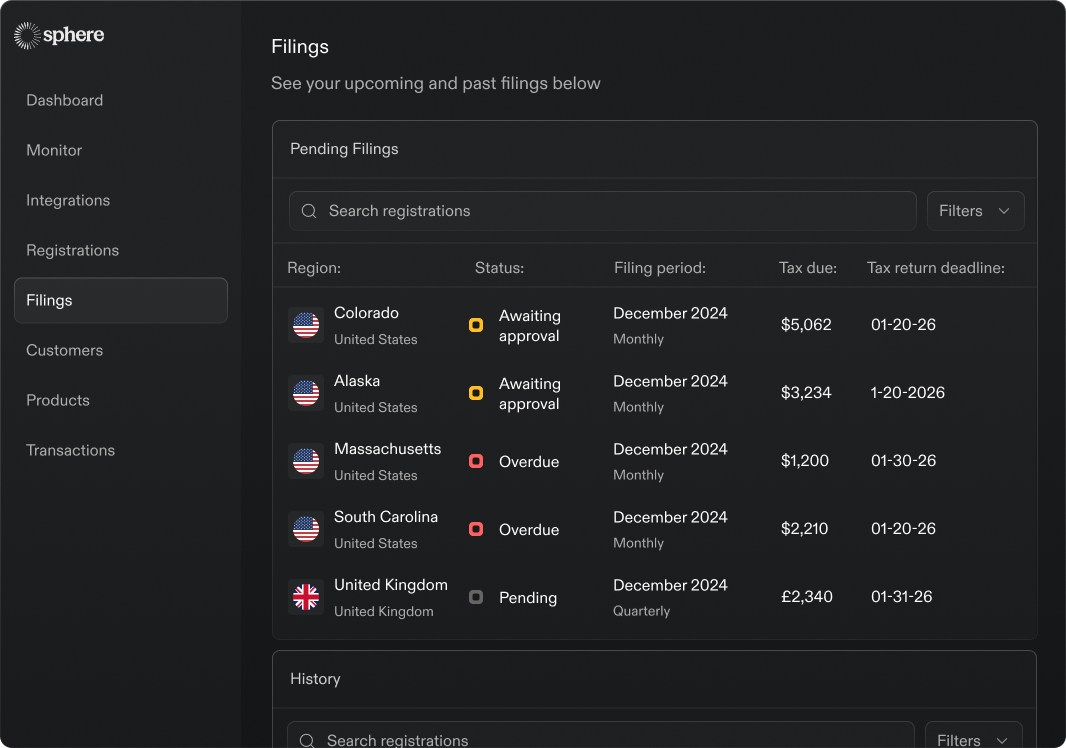.png)
More and more SaaS and AI companies are expanding cross-border into exciting and lucrative global markets. However, with each new country or jurisdiction comes the need for tax compliance.
Finance teams, who often aren’t well-versed in the nuances of global tax compliance, must learn how to obtain a value-added tax (VAT) or goods and services tax (GST) ID, charge the right amount of tax to the right customers, and file and remit tax correctly.
Learning the basics of VAT and GST are vital for forward-looking SaaS and AI companies ready to take on the world.
What Is a VAT/GST ID?
A VAT/GST ID is a unique alphanumeric identifier assigned to businesses registered to collect value-added tax (VAT) or goods and services tax (GST). Local tax authorities issue this number when a business registers for indirect tax obligations. The number must appear on invoices, tax returns, and official documentation.
Key purposes of a VAT/GST ID:
- Tax compliance tracking - Enables authorities to monitor transactions and verify proper tax collection
- Invoice validation - Required on invoices to legitimize tax charges and support tax credit claims
- Rate determination - Helps identify correct tax rates for specific transactions and business types
- Cross-border trade - Essential for international transactions to apply proper tax treatment
- Input tax recovery - Allows registered businesses to claim credits on business purchase taxes
- Audit documentation - Creates a compliance trail for tax authority reviews
Why a VAT/GST ID Matters for SaaS Companies
It’s easy for SaaS companies to sell their digital products cross-border. But the need to comply with VAT or GST can be triggered from the very first sale into a new country, even without physical presence.
Having a VAT, GST, or other required tax IDs ensures you charge and are charged tax correctly, and, where applicable, that you can reclaim tax paid as credits.
Examples of VAT/GST ID Formats
The format varies by country - EU VAT numbers start with country codes plus a country-specific number of digits and/or characters, while other nations like Australia use different GST number structures. For global businesses, each jurisdiction typically requires separate registration and unique identifiers, making automated tax solutions valuable for multi-market compliance.
Tax ID Examples:
- European Union - Includes a country code plus digits and/or characters. Examples:
- Ireland - IE1234567WA (can include letters);
- Germany - DE123456789 (only includes digits)
- Great Britain - Country code with digits: GB123456789
- Australia - A unique 11-digit number. Example: 12345678912
- Canada - Example: 123456789RT0001. This number includes:
- 9-digit Business Number (BN)
- 2-letter program identifier code (generally “RT”)
- 4-digit reference number starting with 0001 to specify different accounts that may be held by a single business
You must have a tax ID number for each jurisdiction in which you sell. For example, your California sales tax ID won’t suffice as a tax ID when selling into the EU.
When Does a SaaS Company Need a VAT or GST ID?
When a business needs to comply with a country’s tax scheme depends on several factors, such as making a certain amount of sales or establishing physical presence.
Common Triggers for Tax Registration
Some countries only require businesses to register and collect tax once their sales exceed a certain threshold. This includes:
- Australia - more than $75k AUD
- Canada (Federal GST / HST) – $30k CAD
- United Kingdom – £90k for UK entities (zero for entities outside the UK)
However, it’s important to note that many countries don’t have a threshold, and companies must register and begin collecting VAT or GST from the first B2C sale into the country.
Example: Your business sells digital books to consumers in the EU. You’d be required to register and collect VAT from your first sale to an EU buyer.
Physical Presence or Local Entity
A business generally always has to collect tax in a country where they have a physical presence like an office, store, warehouse, or even simply if they store inventory there.
Voluntary Registration Scenarios
In some cases, your company might want to register for VAT or GST even if you aren’t (yet) required to. For example, you may be able to reclaim VAT paid if you are registered. Having a VAT, GST, or other tax ID also makes doing business easier for your vendors and buyers in a country, so you may choose to register in order to build trust and goodwill.
How to Get a VAT/GST ID
Determine Where You Need to Register
SaaS and AI businesses should keep a close eye on both sales location and volume.
- Customer location – When selling to buyers in a new country, determine if that sale triggered tax liability.
- Sales volume – If a country requires that your business exceed a certain sales threshold, monitor your revenue as soon as you start making sales in a new country.
The business model also comes into play here. In some instances, if a company only sells to other businesses (B2B) then registration isn’t required.
Prepare Required Documentation
When it comes to how to register for VAT, GST, or another tax scheme, every country and taxing jurisdiction has different requirements.
Commonly required documentation includes:
- Business identifying information – name, address, contact information, tax ID number, etc.
- Officer or beneficial owner identifying information – names, addresses, contact info, IDs, personal tax ID numbers
- Business formation documents – Articles of incorporation, etc.
- Bank details – Bank account information and numbers for payment and refunds
- Financial documents – Bank statements, balance sheets, and other financial info
- Sales info – information about products and services sold
Some taxing jurisdictions require that you have a local bank account or local representative to represent your interests in the country.
Submit Applications Through Tax Authorities
Each country and/or tax jurisdiction has its own digital portal for you to register. The length and complexity of the registration process varies greatly from country to country.
Commonly used tax registration portals:
- United Kingdom - HMRC Online Services portal
- Australia - Australian Tax office (ATO)
- European Union - VAT One Stop Shop
- Canada - Canada Revenue Agency
Timeline and Confirmation
Approval time varies from instantly to several weeks or even longer than a month. Set reminders to check back in case there is a problem with your registration.
What Happens If You Don’t Have or Provide a VAT/GST ID
Tax May be Charged Unnecessarily
Without a tax ID, you may be treated like a consumer and be made to pay taxes that you wouldn’t have to pay as a business.
For example, when making a purchase from a vendor in France, you’d be charged 20% VAT if you don’t have an EU VAT ID, even if you are making the purchase for non-taxable business use.
You May Miss Out on Input Tax Credit Opportunities
When paying VAT on business purchases, registered businesses can reclaim that VAT on their tax filings. If you aren’t registered, you’ll pay that VAT out of pocket with no opportunity to reclaim it. VAT can be up to 27% of a purchase, making this a significant expense.
You Risk Non-Compliance or Penalties
If you haven’t registered for VAT when your business is required to, you can face steep penalties, an audit, or even the revocation of your permission to do business in a country.
VAT and GST compliance can be complicated, but ignoring your indirect tax obligations isn’t worth the risks of noncompliance.
VAT/GST Scenarios for SaaS Companies
You may find yourself facing several different VAT/GST scenarios as your business goes international.
Purchasing from a Registered Supplier in Your Country
This is the most common VAT or GST scenario. VAT and GST are generally charged at every step of the supply chain.
For example, you make a purchase from a supplier (i.e. another business) in a country where you are based. Unless the items are zero-rated or tax-exempt, the supplier charges you VAT/GST. From there, you can claim a credit on the VAT/GST paid on your tax return.
Purchasing from a Foreign Supplier
When making a purchase from a foreign supplier who is not required to register for VAT/GST in your country, they may apply the “reverse charge mechanism.” In this case, they’ll send an invoice stating that reverse charge applies. On your end, rather than paying the tax to your supplier, you’ll keep track of the VAT/GST you should have paid on the transaction and include it with your tax return. This process facilitates doing business cross-border with non-registered companies.
Purchasing from a Non-Registered Supplier
When purchasing from a non-registered supplier, you should not be charged or pay VAT/GST. In this case, be diligent about not attempting to reclaim unpaid VAT.
Selling to B2B Customers Abroad
When you’re the seller and are selling to businesses abroad, be sure to correctly apply the reverse charge mechanism. In the EU, it’s required that you list your VAT ID on the invoice in order to comply with the governing body’s tax policies. Failure to do so will require that you pay the unpaid VAT.
Best Practices for Managing VAT/GST ID Compliance
Handling indirect taxes, especially when your business expands across borders, can be tricky. Here are our best practices to stay organized.
Keep Your Records Organized
Each VAT or GST registration creates its own paper trail of registration IDs, portal logins, filings, and payments. You may also find yourself receiving and storing tax exemption certificates, tax law or rate change notices, and other important items. We recommend organizing and storing these items for easy access.
Monitor Thresholds Automatically
Taxing authorities have little patience with companies who “didn’t realize” they had to register and collect VAT or GST. We recommend using automatic threshold tracking, like Sphere, to let you know when you become liable to register. They’ll even automatically register for you!
Validate Customer VAT IDs Before Invoicing
Failing to collect VAT or other taxes when you were supposed to can leave your business on the hook for interest and penalties. Always validate your customer’s tax IDs before making a tax collection decision. Unfortunately, fraudsters will try to get away without paying VAT/GST.
Include IDs on Invoices
Always invoice correctly in line with the jurisdiction’s policy. Include seller and buyer VAT IDs where applicable, or reinforce good policy by going above and beyond and including them on every invoice. Also be sure to include the appropriate “reverse charge” language when applying the reverse charge mechanism.
Don’t Risk It: Stay Compliant with VAT/GST ID Rules
A VAT or GST ID isn't just another number. It's your ticket to legitimate global business operations and tax compliance. Without proper registration and tax compliance management, your SaaS company faces steep penalties, incorrect invoicing that frustrates customers, and the very real risk of being barred from doing business in key markets.
The cost of inaction far outweighs the effort of getting compliant. For growing SaaS businesses juggling multiple jurisdictions, Sphere's AI-powered platform automates the heavy lifting of ID monitoring, validation, and registration workflows, so you can focus on scaling your business instead of wrestling with the complexities of indirect tax.









.png)
.png)





